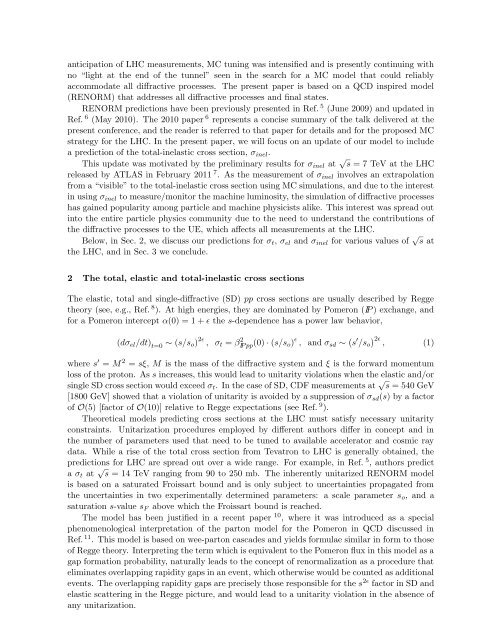2011 QCD and High Energy Interactions - Rencontres de Moriond ...
2011 QCD and High Energy Interactions - Rencontres de Moriond ...
2011 QCD and High Energy Interactions - Rencontres de Moriond ...
You also want an ePaper? Increase the reach of your titles
YUMPU automatically turns print PDFs into web optimized ePapers that Google loves.
anticipation of LHC measurements, MC tuning was intensified <strong>and</strong> is presently continuing with<br />
no “light at the end of the tunnel” seen in the search for a MC mo<strong>de</strong>l that could reliably<br />
accommodate all diffractive processes. The present paper is based on a <strong>QCD</strong> inspired mo<strong>de</strong>l<br />
(RENORM) that addresses all diffractive processes <strong>and</strong> final states.<br />
RENORM predictions have been previously presented in Ref. 5 (June 2009) <strong>and</strong> updated in<br />
Ref. 6 (May 2010). The 2010 paper 6 represents a concise summary of the talk <strong>de</strong>livered at the<br />
present conference, <strong>and</strong> the rea<strong>de</strong>r is referred to that paper for <strong>de</strong>tails <strong>and</strong> for the proposed MC<br />
strategy for the LHC. In the present paper, we will focus on an update of our mo<strong>de</strong>l to inclu<strong>de</strong><br />
a prediction of the total-inelastic cross section, σinel.<br />
This update was motivated by the preliminary results for σinel at √ s = 7 TeV at the LHC<br />
released by ATLAS in February <strong>2011</strong> 7 . As the measurement of σinel involves an extrapolation<br />
from a “visible” to the total-inelastic cross section using MC simulations, <strong>and</strong> due to the interest<br />
in using σinel to measure/monitor the machine luminosity, the simulation of diffractive processes<br />
has gained popularity among particle <strong>and</strong> machine physicists alike. This interest was spread out<br />
into the entire particle physics community due to the need to un<strong>de</strong>rst<strong>and</strong> the contributions of<br />
the diffractive processes to the UE, which affects all measurements at the LHC.<br />
Below, in Sec. 2, we discuss our predictions for σt, σel <strong>and</strong> σinel for various values of √ s at<br />
the LHC, <strong>and</strong> in Sec. 3 we conclu<strong>de</strong>.<br />
2 The total, elastic <strong>and</strong> total-inelastic cross sections<br />
The elastic, total <strong>and</strong> single-diffractive (SD) pp cross sections are usually <strong>de</strong>scribed by Regge<br />
theory (see, e.g., Ref. 8 ). At high energies, they are dominated by Pomeron (IP ) exchange, <strong>and</strong><br />
for a Pomeron intercept α(0) = 1 + ɛ the s-<strong>de</strong>pen<strong>de</strong>nce has a power law behavior,<br />
(dσel/dt) t=0 ∼ (s/so) 2ɛ , σt = β 2 IP pp(0) · (s/so) ɛ , <strong>and</strong> σsd ∼ s ′ 2ɛ /so , (1)<br />
where s ′ = M 2 = sξ, M is the mass of the diffractive system <strong>and</strong> ξ is the forward momentum<br />
loss of the proton. As s increases, this would lead to unitarity violations when the elastic <strong>and</strong>/or<br />
single SD cross section would exceed σt. In the case of SD, CDF measurements at √ s = 540 GeV<br />
[1800 GeV] showed that a violation of unitarity is avoi<strong>de</strong>d by a suppression of σsd(s) by a factor<br />
of O(5) [factor of O(10)] relative to Regge expectations (see Ref. 9 ).<br />
Theoretical mo<strong>de</strong>ls predicting cross sections at the LHC must satisfy necessary unitarity<br />
constraints. Unitarization procedures employed by different authors differ in concept <strong>and</strong> in<br />
the number of parameters used that need to be tuned to available accelerator <strong>and</strong> cosmic ray<br />
data. While a rise of the total cross section from Tevatron to LHC is generally obtained, the<br />
predictions for LHC are spread out over a wi<strong>de</strong> range. For example, in Ref. 5 , authors predict<br />
a σt at √ s = 14 TeV ranging from 90 to 250 mb. The inherently unitarized RENORM mo<strong>de</strong>l<br />
is based on a saturated Froissart bound <strong>and</strong> is only subject to uncertainties propagated from<br />
the uncertainties in two experimentally <strong>de</strong>termined parameters: a scale parameter so, <strong>and</strong> a<br />
saturation s-value sF above which the Froissart bound is reached.<br />
The mo<strong>de</strong>l has been justified in a recent paper 10 , where it was introduced as a special<br />
phenomenological interpretation of the parton mo<strong>de</strong>l for the Pomeron in <strong>QCD</strong> discussed in<br />
Ref. 11 . This mo<strong>de</strong>l is based on wee-parton casca<strong>de</strong>s <strong>and</strong> yields formulae similar in form to those<br />
of Regge theory. Interpreting the term which is equivalent to the Pomeron flux in this mo<strong>de</strong>l as a<br />
gap formation probability, naturally leads to the concept of renormalization as a procedure that<br />
eliminates overlapping rapidity gaps in an event, which otherwise would be counted as additional<br />
events. The overlapping rapidity gaps are precisely those responsible for the s 2ɛ factor in SD <strong>and</strong><br />
elastic scattering in the Regge picture, <strong>and</strong> would lead to a unitarity violation in the absence of<br />
any unitarization.








![List of participants 27/2/09 [pdf] - Rencontres de Moriond - IN2P3](https://img.yumpu.com/17975746/1/190x135/list-of-participants-27-2-09-pdf-rencontres-de-moriond-in2p3.jpg?quality=85)







